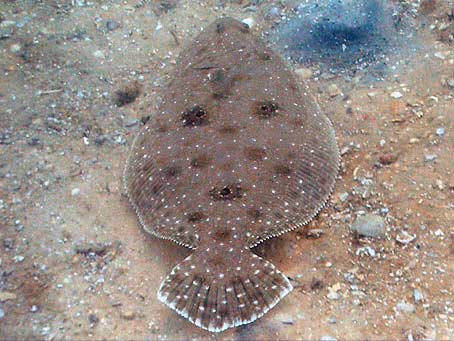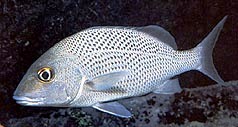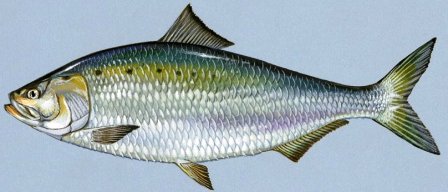Discover Florida Nature
It's time to explore the natural Florida


|
|
|
|
|
 Gulf
Flounder
(Paralichthys albigutta) The flounders are easily
recognized because their side is actually their top. Their dorsal and
ventral fins run the length of the body and both their eyes are on the
same side. The gulf flounder body color is brown overall, and can vary
in shade depending on the color of the substratum. There are numerous
splotches and spots on the upper surface of the body, with 3 ocellated
(eye-like) spots prominent: two are posterior to the pectoral fin, and
one is located inside the base of the tail. Together, these form a
triangle on the body surface .It hatches into a usual fish form, but the
right eye eventually migrates over to the left side. The blindside is
white or dusky. The common size for the gulf flounder fish is up to 2
lbs. and 15 inches long. The Gulf Flounder has strong canine-like teeth.
The Gulf Flounder feeds on crustaceans and small fishes. Although
flounder will strike artificial baits such as jigs and gold spoons, live
bait such as small, live shrimp, mud minnows and finger mullet is far
more effective. These fish are found on soft bottoms in calm and
shallow water and also found in grassy refuges or patches of rock and
pebbles. Gulf
Flounder
(Paralichthys albigutta) The flounders are easily
recognized because their side is actually their top. Their dorsal and
ventral fins run the length of the body and both their eyes are on the
same side. The gulf flounder body color is brown overall, and can vary
in shade depending on the color of the substratum. There are numerous
splotches and spots on the upper surface of the body, with 3 ocellated
(eye-like) spots prominent: two are posterior to the pectoral fin, and
one is located inside the base of the tail. Together, these form a
triangle on the body surface .It hatches into a usual fish form, but the
right eye eventually migrates over to the left side. The blindside is
white or dusky. The common size for the gulf flounder fish is up to 2
lbs. and 15 inches long. The Gulf Flounder has strong canine-like teeth.
The Gulf Flounder feeds on crustaceans and small fishes. Although
flounder will strike artificial baits such as jigs and gold spoons, live
bait such as small, live shrimp, mud minnows and finger mullet is far
more effective. These fish are found on soft bottoms in calm and
shallow water and also found in grassy refuges or patches of rock and
pebbles.  White
Grunt
(plumieri) The body of the white grunt is moderately
elongate, with an elevated and compressed back. The head is long with a
sharp snout. Dorsal and anal fins of the white grunt are completely
covered with scales. The caudal fin is forked and the pectoral fin long
and falcate. The white grunt is silvery white to cream-colored, the head
is bronze to yellow dorsally while the ventral side of the head and
belly is white. Commonly reaching lengths of 17 inches and weights of
5.5 pounds, the white grunt is not a large fish.The distribution of the
white grunt is limited to the western Atlantic Ocean, from the
Chesapeake Bay to the eastern Gulf of Mexico and Caribbean Sea, south to
Brazil. The white grunt is commonly found from the shoreline to the
outer reef edge to depths of 80 feet and occasionally offshore over hard
bottoms to depths of 115 feet. The adults form schools with other
species of fish during the day over coral reefs or sandy bottoms.
Juvenile white grunts reside inshore in seagrass beds, seeking the
shelter among the spines of the long-spined sea urchin. Grunts produce
grunting sounds, hence their common name, by grinding the pharyngeal
teeth, amplifying the sound with the air bladder. The white grunt
frequently exhibits territorial kissing displays, consisting of two fish
in confrontation, pushing each other on the lips with mouths open wide.
The white grunt feeds nocturnally, migrating off the reefs to open
sandy, muddy, or grassy areas. Typically moving off the reef shortly
after sunset and returning to the reef just prior to sunrise, large
white grunts are the first to leave and last the return. This fish is
considered a generalized carnivore, scavenging benthic crustaceans,
mollusks, echinoderms, and small fishes. White
Grunt
(plumieri) The body of the white grunt is moderately
elongate, with an elevated and compressed back. The head is long with a
sharp snout. Dorsal and anal fins of the white grunt are completely
covered with scales. The caudal fin is forked and the pectoral fin long
and falcate. The white grunt is silvery white to cream-colored, the head
is bronze to yellow dorsally while the ventral side of the head and
belly is white. Commonly reaching lengths of 17 inches and weights of
5.5 pounds, the white grunt is not a large fish.The distribution of the
white grunt is limited to the western Atlantic Ocean, from the
Chesapeake Bay to the eastern Gulf of Mexico and Caribbean Sea, south to
Brazil. The white grunt is commonly found from the shoreline to the
outer reef edge to depths of 80 feet and occasionally offshore over hard
bottoms to depths of 115 feet. The adults form schools with other
species of fish during the day over coral reefs or sandy bottoms.
Juvenile white grunts reside inshore in seagrass beds, seeking the
shelter among the spines of the long-spined sea urchin. Grunts produce
grunting sounds, hence their common name, by grinding the pharyngeal
teeth, amplifying the sound with the air bladder. The white grunt
frequently exhibits territorial kissing displays, consisting of two fish
in confrontation, pushing each other on the lips with mouths open wide.
The white grunt feeds nocturnally, migrating off the reefs to open
sandy, muddy, or grassy areas. Typically moving off the reef shortly
after sunset and returning to the reef just prior to sunrise, large
white grunts are the first to leave and last the return. This fish is
considered a generalized carnivore, scavenging benthic crustaceans,
mollusks, echinoderms, and small fishes.  American
Shad Herring (Alosa sapidissima) American shad is an anadromous
species, meaning it comes into fresh water to spawn. American Shad are
distributed along the Atlantic coast from southern Labrador to northern
Florida. American shad undergo extensive seasonal migrations, moving
into rivers for spawning beginning in January in southern rivers, and
continuing until July in the northernmost portion of their range. After
spawning, shad migrate north along the coast to Canada where they feed
during the summer. A southward migration occurs later along the
continental shelf where the fish overwinter prior to spring spawning
migrations to their natal rivers. American
Shad Herring (Alosa sapidissima) American shad is an anadromous
species, meaning it comes into fresh water to spawn. American Shad are
distributed along the Atlantic coast from southern Labrador to northern
Florida. American shad undergo extensive seasonal migrations, moving
into rivers for spawning beginning in January in southern rivers, and
continuing until July in the northernmost portion of their range. After
spawning, shad migrate north along the coast to Canada where they feed
during the summer. A southward migration occurs later along the
continental shelf where the fish overwinter prior to spring spawning
migrations to their natal rivers.The American shad is one of the best-known shad species, as well as the largest—and allegedly one of the tastiest. It is also known as shad, Atlantic shad, and white shad. It can be easily distinguished by its sharp saw-like scales or "scutes" along its belly. The belly has a distinct keel, and the body is moderately compressed. A handsome fish, the American shad has a lustrous green or greenish blue back with silvery sides and a white belly. Its colors darken to a brownish shade when it enters fresh water to spawn. Adults may also have one or more dark spots in a row, or, more rarely, two rows, behind the operculum or gill flap. The American shad's lower jaw has a pointed tip that fits into v-shaped notch in the upper jaw. While most catches of shad are two-three pounds, a five pound American shad is common. This fish has an average life span of five years. American shad feed on plankton, mainly copepods, amphipods, shrimp, and mysids, and occasionally on small fishes. Feeding ceases during upstream spawning migration and resumes post-spawning during the downstream migration. American shad larvae feed primarily on copepods and insect larvae. Historic declines in abundance of American shad in the Hudson and Connecticut Rivers (as well as in rivers in Maryland, North Carolina, and Florida) have been attributed to overfishing and degradation of riverine habitat quality. Dam construction and pollution have also been factors contributing to the decline and almost complete disappearance of shad in many watersheds. Measures to boost the American shad population include hatcheries and fitting dams and blockages on rivers with fish passages to allow American shad to reach their historical spawning areas. Since the completion of such dams on the lower Columbia River, shad populations have started to rise. |
|
|
Advertise | Privacy Statement | Dog Encyclopedia | Video |Contact | Alaska Nature |
|